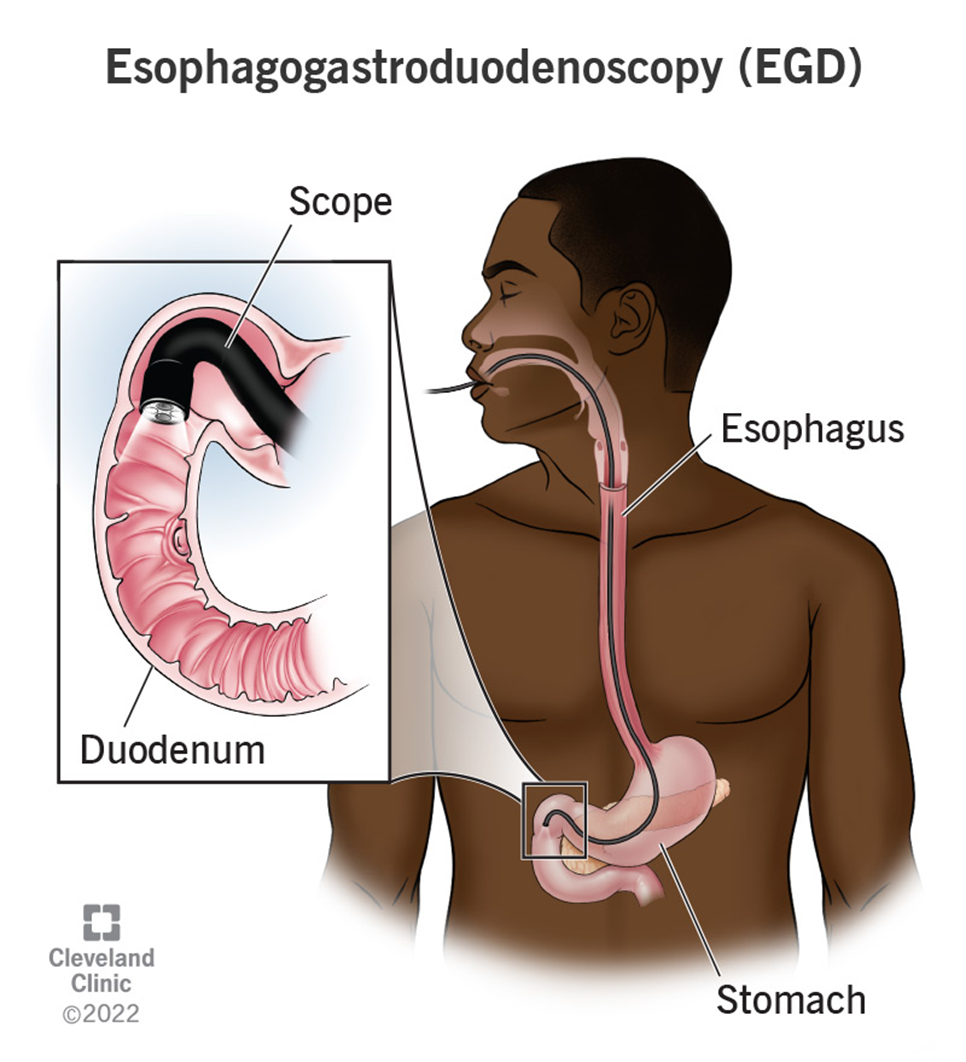The nurse is caring for a client recovering from an esophagogastroduodenoscopy (EGD). Which of the following client symptoms would require further nursing assessment?
Thirst
Sore throat
Abdominal distention
Drowsiness
The Correct Answer is C
Choice A Reason:
Thirst is a common and expected symptom after an EGD, especially if the client has been fasting before the procedure. It does not typically indicate a complication and can be managed by gradually reintroducing fluids as tolerated. Therefore, thirst does not require further nursing assessment beyond routine post-procedure care.
Choice B Reason:
A sore throat is also a common symptom following an EGD. The procedure involves passing an endoscope through the throat, which can cause temporary irritation and discomfort. This symptom usually resolves on its own within a few days and does not indicate a serious complication. Therefore, a sore throat does not require further nursing assessment beyond providing comfort measures such as lozenges or warm saltwater gargles.
Choice C Reason:
Abdominal distention is a concerning symptom that requires further nursing assessment. It can indicate complications such as perforation, bleeding, or infection following the EGD. Perforation of the gastrointestinal tract is a rare but serious complication that can lead to peritonitis and sepsis if not promptly addressed. Therefore, any signs of abdominal distention should be reported to the provider immediately for further evaluation and intervention.

Choice D Reason:
Drowsiness is a common side effect of the sedatives used during the EGD procedure. It is expected that the client may feel drowsy or sleepy for a few hours after the procedure as the sedative wears off. This symptom does not typically require further nursing assessment unless it persists for an unusually long time or is accompanied by other concerning symptoms such as difficulty breathing or altered mental status.
Nursing Test Bank
Naxlex Comprehensive Predictor Exams
Related Questions
Correct Answer is C
Explanation
Choice A Reason:
Administering levetiracetam intravenously is not the first intervention. While levetiracetam is an antiepileptic drug used to control seizures, it is not the first-line treatment for an ongoing seizure, especially one lasting as long as 15 minutes. The priority in this situation is to stop the seizure activity immediately to prevent further complications, such as neuronal damage or status epilepticus. Levetiracetam may be used later for maintenance therapy, but it is not the initial emergency intervention.
Choice B Reason:
Obtaining a STAT electroencephalogram (EEG) is important for diagnosing and understanding the type of seizure activity, but it is not the first intervention. The immediate priority is to stop the seizure. An EEG can be performed after the seizure has been controlled to assess brain activity and guide further treatment. Delaying the administration of an anticonvulsant to perform an EEG could result in prolonged seizure activity and increased risk of complications.
Choice C Reason:
Administering lorazepam intravenously is the most appropriate first intervention. Lorazepam is a benzodiazepine that acts quickly to stop seizure activity. It is the drug of choice for treating status epilepticus and prolonged seizures because of its rapid onset and effectiveness. Administering lorazepam helps to quickly terminate the seizure, reducing the risk of complications and stabilizing the patient for further evaluation and treatment.
Choice D Reason:
Obtaining a STAT 12-lead electrocardiogram (ECG) is not the first intervention. While an ECG can provide valuable information about the patient’s cardiac status, it does not address the immediate need to stop the seizure. The priority is to administer an anticonvulsant to terminate the seizure. Once the seizure is controlled, an ECG can be performed to assess any potential cardiac issues, especially if the patient has a history of cardiac problems or if the seizure was triggered by a cardiac event.
Correct Answer is A
Explanation
Choice A Reason:
Hemoptysis, or coughing up blood, is a common feature of both mitral valve stenosis and mitral valve regurgitation. In mitral valve stenosis, the narrowing of the valve leads to increased pressure in the pulmonary veins, which can cause pulmonary congestion and hemoptysis. Similarly, in mitral valve regurgitation, the backflow of blood into the left atrium increases pulmonary pressure, potentially leading to pulmonary edema and hemoptysis. Therefore, hemoptysis is a shared symptom of both conditions.
Choice B Reason:
A high-pitched holosystolic murmur is more commonly associated with mitral valve regurgitation rather than mitral valve stenosis. In mitral valve regurgitation, the murmur is caused by the backflow of blood from the left ventricle into the left atrium during systole3. Mitral valve stenosis, on the other hand, typically presents with a diastolic murmur due to the turbulent flow of blood through the narrowed valve during diastole. Therefore, a high-pitched holosystolic murmur is not a common feature of both disorders.
Choice C Reason:
Hepatomegaly, or an enlarged liver, can occur in advanced cases of both mitral valve stenosis and mitral valve regurgitation due to right-sided heart failure. However, it is not a primary or common feature of these conditions. Hepatomegaly is more often associated with conditions that directly affect the right side of the heart or cause systemic congestion. Therefore, hepatomegaly is not a common feature of both mitral valve stenosis and mitral valve regurgitation.
Whether you are a student looking to ace your exams or a practicing nurse seeking to enhance your expertise , our nursing education contents will empower you with the confidence and competence to make a difference in the lives of patients and become a respected leader in the healthcare field.
Visit Naxlex, invest in your future and unlock endless possibilities with our unparalleled nursing education contents today
Report Wrong Answer on the Current Question
Do you disagree with the answer? If yes, what is your expected answer? Explain.
Kindly be descriptive with the issue you are facing.
